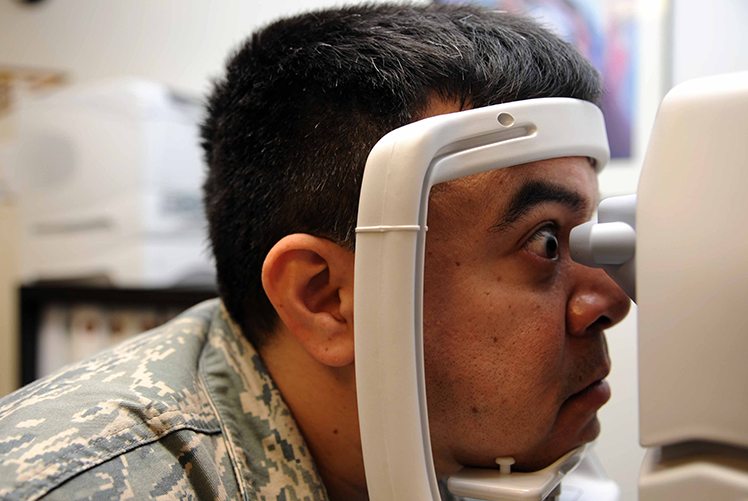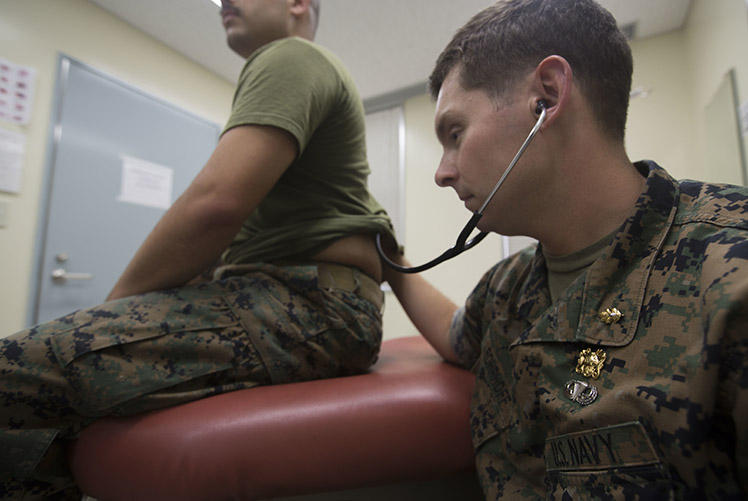If you're having trouble finding what you're looking for, consider using fewer words in
your search criteria. Results are limited to content that matches all terms in the search field.
Article
2/1/2019

Malaria infection remains an important health threat to U.S. service members who are located in endemic areas because of long-term duty assignments, participation in shorter-term contingency operations, or personal travel. In 2018, a total of 58 service members were diagnosed with or reported to have malaria. This represents a 65.7% increase from the 35 cases identified in 2017. The relatively low numbers of cases during 2012–2018 mainly reflect decreases in cases acquired in Afghanistan, a reduction due largely to the progressive withdrawal of U.S. forces from that country. The percentage of cases of malaria caused by unspecified agents (63.8%; n=37) in 2018 was the highest during any given year of the surveillance period. The percentage of cases identified as having been caused by Plasmodium vivax (10.3%; n=6) in 2018 was the lowest observed during the 10-year surveillance period. The percentage of malaria cases attributed to P. falciparum (25.9 %) in 2018 was similar to that observed in 2017 (25.7%), although the number of cases increased. Malaria was diagnosed at or reported from 31 different medical facilities in the U.S., Afghanistan, Italy, Germany, Djibouti, and Korea. Providers of medical care to military members should be knowledgeable of and vigilant for clinical manifestations of malaria outside of endemic areas.
Article
2/1/2019

Glaucoma is an eye disease that involves progressive optic nerve damage and vision loss, leading to blindness if undetected or untreated. This report describes an analysis using the Defense Medical Surveillance System to identify all active component service members with an incident diagnosis of glaucoma during the period between 2013 and 2017. The analysis identified 37,718 incident cases of glaucoma and an overall incidence rate of 5.9 cases per 1,000 person-years (p-yrs). The majority of cases (97.6%) were diagnosed at an early stage as borderline glaucoma; of these borderline cases, 2.2% progressed to open-angle glaucoma during the study period. No incident cases of absolute glaucoma, or total blindness, were identified. Rates of glaucoma were higher among non-Hispanic black (11.0 per 1,000 p-yrs), Asian/Pacific Islander (9.5), and Hispanic (6.9) service members, compared with non-Hispanic white (4.0) service members. Rates among female service members (6.6 per 1,000 p-yrs) were higher than those among male service members (5.8). Between 2013 and 2017, incidence rates of glaucoma diagnoses increased by 75.4% among all service members.
Article
2/1/2019

Human adenoviruses (HAdVs) are known to cause respiratory illness outbreaks at basic military training (BMT) sites. HAdV type-4 and -7 vaccines are routinely administered at enlisted BMT sites, but not at military academies. During Aug.–Sept. 2016, U.S. Naval Academy clinical staff noted an increase in students presenting with acute respiratory illness (ARI). An investigation was conducted to determine the extent and cause of the outbreak. During 22 Aug.–11 Sept. 2016, 652 clinic visits for ARI were identified using electronic health records. HAdV-4 was confirmed by real-time polymerase chain reaction assay in 18 out of 33 patient specimens collected and 1 additional HAdV case was detected from hospital records. Two HAdV-4 positive patients were treated for pneumonia including 1 hospitalized patient. Molecular analysis of 4 HAdV-4 isolates identified genome type 4a1, which is considered vaccine-preventable. Understanding the impact of HAdV in congregate settings other than enlisted BMT sites is necessary to inform discussions regarding future HAdV vaccine strategy.
Article
2/1/2019
The MSMR has been publishing the results of surveillance studies of malaria since 1995. The standard MSMR case definition uses Medical Event Reports and records of hospitalizations in counting cases of malaria. This report summarizes the performance of the standard MSMR case definition in estimating incident cases of malaria from 2015 through 2017. Also explored was the potential surveillance value of including outpatient encounters with diagnoses of malaria or positive laboratory tests for malaria in the case definition. The study corroborated the relative accuracy of the MSMR case definition in estimating malaria incidence and provided the basis for updating the case definition in 2019 to include positive laboratory tests for malaria antigen within 30 days of an outpatient diagnosis.
Article
12/1/2018

This analysis describes the incidence and prevalence of five thyroid disorders (goiter, thyrotoxicosis, primary/not otherwise specified [NOS] hypothyroidism, thyroiditis, and other disorders of the thyroid) among active component service members between 2008 and 2017. During the 10-year surveillance period, the most common incident thyroid disorder among male and female service members was primary/NOS hypothyroidism and the least common were thyroiditis and other disorders of thyroid. Primary/NOS hypothyroidism was diagnosed among 8,641 females (incidence rate: 43.7 per 10,000 person-years [p-yrs]) and 11,656 males (incidence rate: 10.2 per 10,000 p-yrs). Overall incidence rates of all thyroid disorders were 3 to 5 times higher among females compared to males. Among both males and females, incidence of primary/NOS hypothyroidism was higher among non-Hispanic white service members compared with service members in other race/ethnicity groups. The incidence of most thyroid disorders remained stable or decreased during the surveillance period. Overall, the prevalence of most thyroid disorders increased during the first part of the surveillance period and then either decreased or leveled off.31.6 per 100,000 active component service members in 2017. Validation of ICD-9/ICD-10 diagnostic codes for MetS using the National Cholesterol Education Program Adult Treatment Panel III criteria is needed to establish the level of agreement between the two methods for identifying this condition.
Article
12/1/2018

This report uses ICD-9 and ICD-10 codes (277.7 and E88.81, respectively) for the metabolic syndrome (MetS) to summarize trends in the incidence and prevalence of this condition among active component members of the U.S. Armed Forces between 2002 and 2017. During this period, the crude overall incidence rate of MetS was 7.5 cases per 100,000 person-years (p-yrs). Compared to their respective counterparts, overall incidence rates were highest among Asian/Pacific Islanders, Air Force members, and warrant officers and were lowest among those of other/unknown race/ethnicity, Marine Corps members, and junior enlisted personnel and officers. During 2002–2017, the annual incidence rates of MetS peaked in 2009 at 11.6 cases per 100,000 p-yrs and decreased to 5.9 cases per 100,000 p-yrs in 2017. Annual prevalence rates of MetS increased steadily during the first 11 years of the surveillance period reaching a high of 38.9 per 100,000 active component service members in 2012, after which rates declined slightly to
31.6 per 100,000 active component service members in 2017. Validation of ICD-9/ICD-10 diagnostic codes for MetS using the National Cholesterol Education Program Adult Treatment Panel III criteria is needed to establish the level of agreement between the two methods for identifying this condition.
Article
12/1/2018

During 2002–2017, the most common incident adrenal gland disorder among male and female service members was adrenal insufficiency and the least common was adrenomedullary hyperfunction. Adrenal insufficiency was diagnosed among 267 females (crude overall incidence rate: 8.2 cases per 100,000 person-years [p-yrs]) and 729 males (3.9 per 100,000 p-yrs). In both sexes, overall rates of other disorders of adrenal gland and Cushing’s syndrome were lower than for adrenal insufficiency but higher than for hyperaldosteronism, adrenogenital disorders, and adrenomedullary hyperfunction. Crude overall rates of adrenal gland disorders among females tended to be higher than those of males, with female:male rate ratios ranging from 2.1 for adrenal insufficiency to 5.5 for androgenital disorders and Cushing’s syndrome. The highest overall rates of adrenal insufficiency for males and females were among non-Hispanic white service members. Among females, rates of Cushing's syndrome and other disorders of adrenal gland were 31.6 per 100,000 active component service members in 2017. Validation of ICD-9/ICD-10 diagnostic codes for MetS using the National Cholesterol Education Program Adult Treatment Panel III criteria is needed to establish the level of agreement between the two methods for identifying this condition.
Article
11/19/2018
In 2016, the U.S. Army Medical Department Activity-Bavaria recorded 108 possible rabies exposures, a 112% increase from the previous year. Of these, 49 (45%) occurred during prior deployments to Egypt and Eastern Europe in which they had not received timely rabies post-exposure prophylaxis.
Article
11/19/2018
This report describes a cluster of 11 soldiers with vivax malaria among U.S. military personnel who trained at Dagmar North training area, near the demilitarized zone (DMZ), in the Republic of Korea (ROK) in 2015. Two cases were diagnosed in the ROK in 2015, one of whom subsequently experienced a relapse, and nine other cases were diagnosed in 2016, 8–11 months after the soldiers had returned to the U.S. Vivax malaria poses a health threat to U.S. Forces Korea operating near the DMZ in the ROK. Continuing and enhanced focus on force health protection measures in endemic zones is warranted.
Article
11/19/2018
For decades, malaria infections acquired in Korea have posed a significant threat to both Korean military and civilians and to U.S. Department of Defense (DOD) personnel. In Korea, malaria infections are caused exclusively by the species Plasmodium vivax (PV). Despite the use of chloroquine chemoprophylaxis during the Korean War (1950–1953), thousands of cases of PV malaria were diagnosed in Korea among U.S. military personnel.1 As troops returned home, however, many more cases were diagnosed stateside, inundating military hospitals and leading to research on the use of primaquine to treat what were termed “late attacks of Plasmodium vivax of Korean origin”.
Article
11/19/2018
This report describes a cluster of 11 soldiers with vivax malaria among U.S. military personnel who trained at Dagmar North training area, near the demilitarized zone (DMZ), in the Republic of Korea (ROK) in 2015. Two cases were diagnosed in the ROK in 2015, one of whom subsequently experienced a relapse, and nine other cases were diagnosed in 2016, 8–11 months after the soldiers had returned to the U.S. Vivax malaria poses a health threat to U.S. Forces Korea operating near the DMZ in the ROK. Continuing and enhanced focus on force health protection measures in endemic zones is warranted.
Article
11/19/2018
This report describes a cluster of 11 soldiers with vivax malaria among U.S. military personnel who trained at Dagmar North training area, near the demilitarized zone (DMZ), in the Republic of Korea (ROK) in 2015. Two cases were diagnosed in the ROK in 2015, one of whom subsequently experienced a relapse, and nine other cases were diagnosed in 2016, 8–11 months after the soldiers had returned to the U.S. Vivax malaria poses a health threat to U.S. Forces Korea operating near the DMZ in the ROK. Continuing and enhanced focus on force health protection measures in endemic zones is warranted.
Article
10/2/2018
From a patient perspective, most of these changes should go unnoticed
Article
6/22/2017
Having DHAPP align under DHA's leadership enables broader opportunities for the organization to expand interagency partnerships and work more closely with the DoD's combatant commands
Article
12/5/2016
The center comes under formal control of the Defense Health Agency Dec. 11, 2016
Page 172 of 174
showing items 2566 - 2580